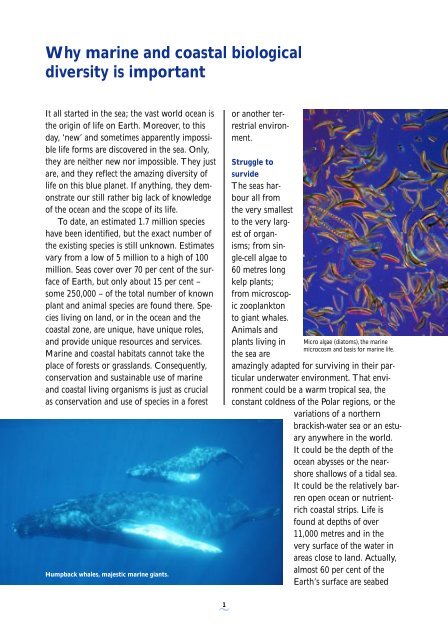The Jakarta Mandate - Convention on Biological Diversity
The Jakarta Mandate - Convention on Biological Diversity
The Jakarta Mandate - Convention on Biological Diversity
You also want an ePaper? Increase the reach of your titles
YUMPU automatically turns print PDFs into web optimized ePapers that Google loves.
Why marine and coastal biologicaldiversity is importantIt all started in the sea; the vast world ocean isthe origin of life <strong>on</strong> Earth. Moreover, to thisday, ‘new’ and sometimes apparently impossiblelife forms are discovered in the sea. Only,they are neither new nor impossible. <str<strong>on</strong>g>The</str<strong>on</strong>g>y justare, and they reflect the amazing diversity oflife <strong>on</strong> this blue planet. If anything, they dem<strong>on</strong>strateour still rather big lack of knowledgeof the ocean and the scope of its life.To date, an estimated 1.7 milli<strong>on</strong> specieshave been identified, but the exact number ofthe existing species is still unknown. Estimatesvary from a low of 5 milli<strong>on</strong> to a high of 100milli<strong>on</strong>. Seas cover over 70 per cent of the surfaceof Earth, but <strong>on</strong>ly about 15 per cent –some 250,000 – of the total number of knownplant and animal species are found there. Speciesliving <strong>on</strong> land, or in the ocean and thecoastal z<strong>on</strong>e, are unique, have unique roles,and provide unique resources and services.Marine and coastal habitats cannot take theplace of forests or grasslands. C<strong>on</strong>sequently,c<strong>on</strong>servati<strong>on</strong> and sustainable use of marineand coastal living organisms is just as crucialas c<strong>on</strong>servati<strong>on</strong> and use of species in a forestHumpback whales, majestic marine giants.or another terrestrialenvir<strong>on</strong>ment.Struggle tosurvide<str<strong>on</strong>g>The</str<strong>on</strong>g> seas harbourall fromthe very smallestto the very largestof organisms;from single-cellalgae to60 metres l<strong>on</strong>gkelp plants;from microscopiczooplankt<strong>on</strong>to giant whales.Animals andplants living in Micro algae (diatoms), the marinemicrocosm and basis for marine life.the sea areamazingly adapted for surviving in their particularunderwater envir<strong>on</strong>ment. That envir<strong>on</strong>mentcould be a warm tropical sea, thec<strong>on</strong>stant coldness of the Polar regi<strong>on</strong>s, or thevariati<strong>on</strong>s of a northernbrackish-water sea or an estuaryanywhere in the world.It could be the depth of theocean abysses or the nearshoreshallows of a tidal sea.It could be the relatively barrenopen ocean or nutrientrichcoastal strips. Life isfound at depths of over11,000 metres and in thevery surface of the water inareas close to land. Actually,almost 60 per cent of theEarth’s surface are seabed1~
















